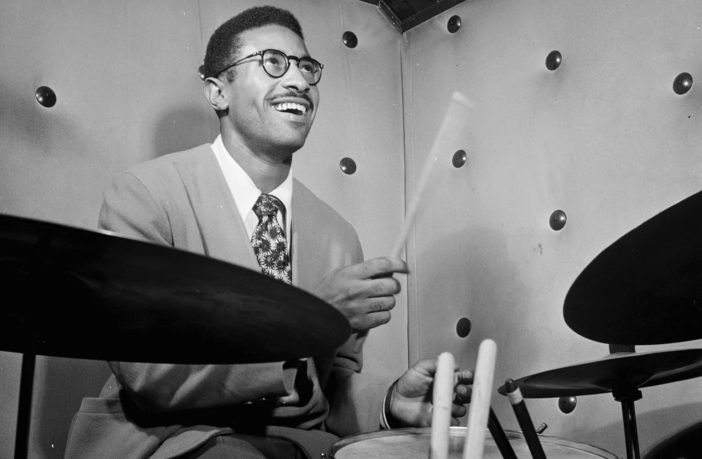“Max Roach 100,” part of a nationwide centennial celebrating the iconic drummer, composer, and activist, takes the stage at the Joyce Theatre from April 2–7, paying tribute to the legendary jazz pioneer with a program of commissioned works by a collection of dance legends in their own right.
Max Roach (1924–2007) was one of the two leading drummers of the bebop era and one of the leading musicians, composers, and bandleaders in jazz since the 1940s. His powerhouse career got off the ground when he was 18 years old and played with the Duke Ellington Orchestra. He went on to work with a who’s who in bebop and jazz, including Dizzy Gillespie, Charlie Parker, Thelonious Monk, Coleman Hawkins, Bud Powell, Miles Davis, Charles Mingus, Abbey Lincoln, Dinah Washington, Benny Carter, Sonny Rollins, Stan Getz, Archie Shepp, Abdullah Ibrahim, Cecil Taylor, and more. He also collaborated with his daughter Maxine Roach, a Grammy-nominated violinist.
At the upcoming Joyce Theatre tribute, Ronald K. Brown’s EVIDENCE: A Dance Company will be joined by the Havana-based Malpaso Dance Company as the two dance groups jam to Roach’s percussive Afro Cuban rhythms in the latest work by Brown and Arcell Cabuag called “Tender Warriors.” Brown said the soundscape for this new dance is Roach’s 1961 album “Percussion Bitter Sweet,” which Roach premiered after an inspiring trip to Cuba. “When you get great music, you can’t get away from it and it dictates the movement,” Brown said as he recalled what it was like to encounter Roach. “The instrumentation—there is so much fire in it. So much fire. The trumpets, the horns—there is so much energy.”
In another piece on the program, “The Dream/It’s Time,” Roach’s band joins a recording of Martin Luther King Jr. in an aspirational and urgent conversation, now amplified by the street dance storytelling of Rennie Harris Puremovement. Tap artist Ayodele Casel, whose rhythmic feet become another percussive instrument in the musical ensemble as she completes the celebratory evening, takes on an explosively theatrical solo set to a series of duets between Roach and fellow jazz pioneer, pianist Cecil Taylor. The program opens with a new film by video artist Kit Fitzgerald featuring archival footage of Roach.
In an interview with the Amsterdam News, Brown’s excitement about the upcoming program is palpable. “I’m very excited. The two companies look so amazing together. Watching them work together is so mind-blowing,” he said. “This is so special.”
The virtuosity of the choreographer who can blend all dance styles into one form must have been new to them. “You know, most of the dancers in Cuba study all of the dance techniques—ballet, folklore, and modern—and at some point, they have to choose one,” Brown said. “When I first worked with them, they were surprised that I used so much Afro-Cuban folk dance in my modern dances.”
With a humble explanation that underscored his own unique African Diasporic style, Brown told them gently that as a Black man from the U.S., this is what he does. “It’s been amazing to see the dancers light up. The music connects to the traditions in both countries.”
The program includes a song called “Garvey’s Ghost,” Brown said, explaining how he wanted to honor Roach’s interest in the Jamaican-born political activist. The title of the music refers to the leader of the United Negro Improvement Association (UNIA), one of this country’s largest Pan-African movements in the early part of the 20th century. “I think Max was impacted by all the work that Garvey was doing, so I had to pull that element into it too. Understanding the Pan-African Movement is so prevalent in the piece. I’m really excited for audiences to see the work. It’s so powerful and so amazing. We’re so proud of it,” Brown said.
The collaboration between Brown’s company and Malpaso not only honors Roach’s music but also pays tribute to the master musician’s history of working with such dance companies as the Alvin Ailey American Dance Theater, Dianne McIntyre Dance Company, and Bill T. Jones/Arnie Zane Dance Company. In 1980, Max Roach and singer Abbey Lincoln performed with McIntyre at the Symphony Space Theater on Manhattan’s Upper West Side.
In an interview with me for the Amsterdam News back then, Roach spoke softly but with an unvarnished frankness about the art he had devoted his life to, the space where his art lives, and a space where art and politics overlap: “The artist’s responsibility is to chronicle the times. We are the secretary of our times, some do it with words, others, abstract artists, do it another way…while culture is for entertainment, its main purpose is enlightenment.”
At the upcoming “Max Roach 100” program, audiences are bound to get a bit of both. For more info, visit www.joyce.org.
Like this:
Like Loading…



